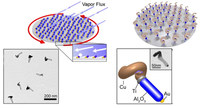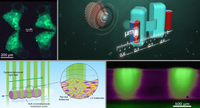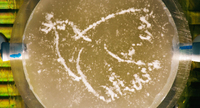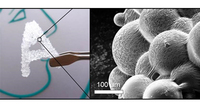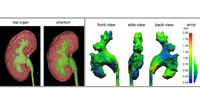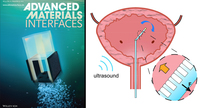In order to realize the first synthetic systems that self-assemble, actively move, and mimic the complex intelligent functions and behavior of biological microorganisms, an interdisciplinary research effort is required. In the Lab for Micro Nano and Molecular Systems we combine research on the physics and chemistry of active matter, with the development of new nano and micro-scale fabrication methods, alongside original engineering approaches to develop new technologies for applications in ultrasonics and for biomedical applications.
Micro
We build microswimmers and use them to explore bio-medically relevant applications. Locomotion in such complex environments requires new strategies for powering and controlling microsystems. We are working on new actuation principles in low Reynolds number hydrodynamics, and are exploring potential applications, including in microrobotics. We also work on directed assembly using ultrasonic fields and the technology of acoustic holograms. Another field of research are self-propelled colloids as model systems for active matter, collective phenomena, and self-organization.
Nano
We develop new nanofabrication methods that are highly parallel and permit the growth of complex three-dimensional nano-shapes and structures. An important aspect in our work is the use of functional materials, e.g. the combination of magnetic, electrical, catalytic, and optically active materials. New fabrication advances allow us to explore fundamental effects in physics and chemistry, and are the basis for the development of new engineering systems at the smallest of scales. We have used our fabrication methods to make some of the smallest robotic systems that have been realized to date.
Molecular
Nature has evolved highly sophisticated motors that inspire our work and we aim to mimic and incorporate in the systems and machinery we develop. We are interested in chirality, and we chemically tailor surfaces and couple nanostructures. We also have a research effort to explore the assembly of machinery from atomic clusters. We work with biological systems and molecules, including (genetically modified) enzymes, and use spectroscopy to observe their function and motion.
M13 bacteriophages
Genetically modified bacteriophages for self-assembly Mariana Alarcon-Correa, Vincent M. Kadiri, Jan-Philipp Günther, Peer Fischer ... Read More
Chemical motors
Chemical motors Dhruv P. Singh, Udit Choudhury, Tingting Yu, Mariana Alarcon-Correa, Mihail Popescu, Peer Fischer Read More
3D Nanofab
3D Nanofabrication: nanoGLAD Dhruv Singh, Melanie Adams, Johannes Sachs, Conny Miksch, Peer Fischer Former members: Hyeon-Ho Jeong, Andrew Mark, John Gibbs, Tung-Chun Lee, Sahand Eslami, Debora Walker Read More
Nanopropellers
Nanopropellers and their Biomedical Application Tian Qiu, Dandan Li, Moon Kwang Jeong, Jonas Troll, Peer Fischer Read More
Microswimmers
Soft microswimmers Stefano Palagi, Tian Qiu, Eunjin Choi, Alexander von Rohr, Peer Fischer Read More
Acoustic Holograms
Acoustic Holograms – a new technology Ultrasound is used in many disciplines. Sound fields can be created to exert forces, transfer power, an... Read More
Smart Organ Phantoms
High-fidelity human organ phantoms Tian Qiu, Eunjin Choi, Stefano Palagi, Peer Fischer Collaborator: Dr. med. Fabian Adams, Department Urology, Medical Center - Uni... Read More
Ultrasonic Microactuators
Ultrasound-powered Robotic Actuation Systems Tian Qiu, Stefano Palagi, Kai Melde, Peer Fischer Read More




